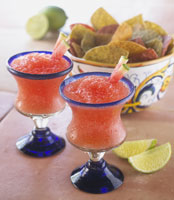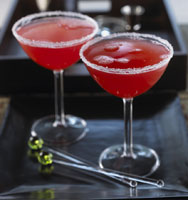

|
This is the best margarita ever! Smooth, cold and full of flavor. Just add sun and a sparkling pool of water. Place all ingredients (except the sun and pool of water!) in a blender and puree until smooth. Serves 2 or 3.
You can add a shot of chilled premium vodka to the shaker and make this mocktail a cocktail! 1 cup watermelon puree Place all of the ingredients in a martini shaker and shake for 20 seconds. Strain the chilled liquid into a sugar rimmed martini glass. Makes 1 or 2 mocktails. POLITICS AND PINOT DOWN UNDER
It was an auspicious beginning. She was returning with her cabinet from meetings in Europe. I exchanged cards with her Press Secretary, sat next to the Minister of Defense and we departed on what felt like New Zealand’s Air Force One. After dropping off the Prime Minister and her entourage in Auckland, we continued on to Adelaide, the Capitol of South Australia. It’s located in about the same spot on the map that New Orleans is in the United States, and the food is spectacular too! But Adelaide is also the gateway to Australia’s finest wine regions.
Wine is a very serious matter in Adelaide. Most of Australia’s fine wines are produced within a 60-mile radius of the city. My cab driver was grousing over a front-page story about Australian wines finishing “dead last” in a tasting competition conducted by the Los Angeles Times. I knew about the contest. It was conducted by five writers in the Food Section who compared some Australian and Californian wines in the under $15 range, Australia topping two categories and California five. Hardly the devastation portrayed in the paper. After touring the museum, a state of the art, multi-media presentation on the wine industry in Australia, I hit the tasting room to get a real feel for what I had just learned. Thankfully, admission includes a tasting of several wines from the 10,000 bottles available for purchase in the wine seller. Surprisingly to me, Australians are the largest per capita consumers of wine in the world, much preferring it to beer. The most popular beers, by the way, are James Boag, Cascade and Cooper. Fosters is not. As I was told by my hotel barkeeper, “Aussies don’t drink Fosters, it’s only for export.” I met my guide, Chris Smyth of Tourabout Adelaide, www.touraboutadelaide.com.au, outside the museum, where we began our walking tour of the city in the Botanical Gardens, stopping for lunch at the Botanic Garden Restaurant, a large, glass encased gazebo-like structure overlooking a pond.With a population just over a million people, Adelaide is a lovely walking city with many fine shops and a vibrant downtown area. A must visit is the Central Market, the largest in-door produce market in the Southern Hemisphere. Also look for Rundle Street to find some of the best bars, cafes, sidewalk dining, funky clothing stores and wine shops. When it becomes the walking street, Rundle Mall, you’ll find the large department stores and fancy shops. Look for The Opal Mine. It has the world’s largest opal on display, “The Fire of Australia.” Its value is priceless. This softball-sized jewel is sitting unprotected in a glass case within easy reach and just a few steps from the front door. There are no guards, only women shopkeepers. Don’t think I didn’t think about it. It’s been there since it was discovered in 1946. And this is a country that was once a penal colony? Any guess how long it would have survived in Los Angeles or New York? Further on is Hindley Street, which is a curious mix of red light zone, university students, inexpensive restaurants and bookstores, dance clubs and lively bars. Look for Chianti Classico on Hutt Street for the best Italian food in the city. I was in Adelaide the day they were electing the new Lord Mayor and staying at the five-star, 163-year-old Medina Grand Adelaide Treasury Apartments, the original site of the city treasury. It has a terrific pub, where I was doing some research for my trip to the wine country. In came Michael Harbison, the lead candidate for Lord Mayor, with his wife, daughter, about 20 supporters, his campaign manager and the They had come to await results of the election and bought drinks for everyone, including yours truly. We talked, exchanged cards, took photographs and in the next day’s paper I was photographed seated next to the new Lord Mayor, toasting his victory. I was beginning to feel like a part of the political establishment Down Under. The next day my guide to the wine country, Mary Anne Kennedy of A Taste of South Australia, www.tastesa.com.au, picked me up at the hotel and we drove north to visit the Barossa and Clare Valleys, the Napa and Sonoma of Australia, about an hour outside the city. The Barossa Valley produces about 25 percent of the wine grown in Australia and contains 60 different wineries, including the largest and most well known. Almost all have tasting rooms and encourage visitors. Many are now using the new Stelvin screw caps instead of corks, to cut down on spoiled wines.
FOOD, WINE AND LODGING: Maggie Beer’s Farm Shop Vintner’s Bar & Grill Peppers Hermitage Penfolds Peter Lehmann Yalumba Henschke CLARE VALLEY Salt n Vines Clare Thorn Park Country House Sevenhill Cellars www.sevenhillcellars.com.au Mount Horrocks Auburn The highlight of my stay was the final evening. Australia’s best-known chef, Cheong Liew of The Grange Restaurant in the Hilton Adelaide, was preparing a six course tasting menu matched with six different area wines, followed by dessert wines and brandies. The menu was designed to tie together my food and wine experience over the past week. If you are in Adelaide, do yourself a favor and dine with Chef Liew, you will remember it the rest of your life. I introduced myself to people sitting at the next table and found that I was speaking with Nick Greiner, the former Premiere of New South Wales. It was a pleasure, but by now I was used to meeting with the powerful and politically entrenched in the land Down Under. GETTING THERE:
|
© 2008 Bonnie Carroll, All Rights Reserved

 Watermelon Mango Margarita
Watermelon Mango Margarita Watermelon Mocktail
Watermelon Mocktail

